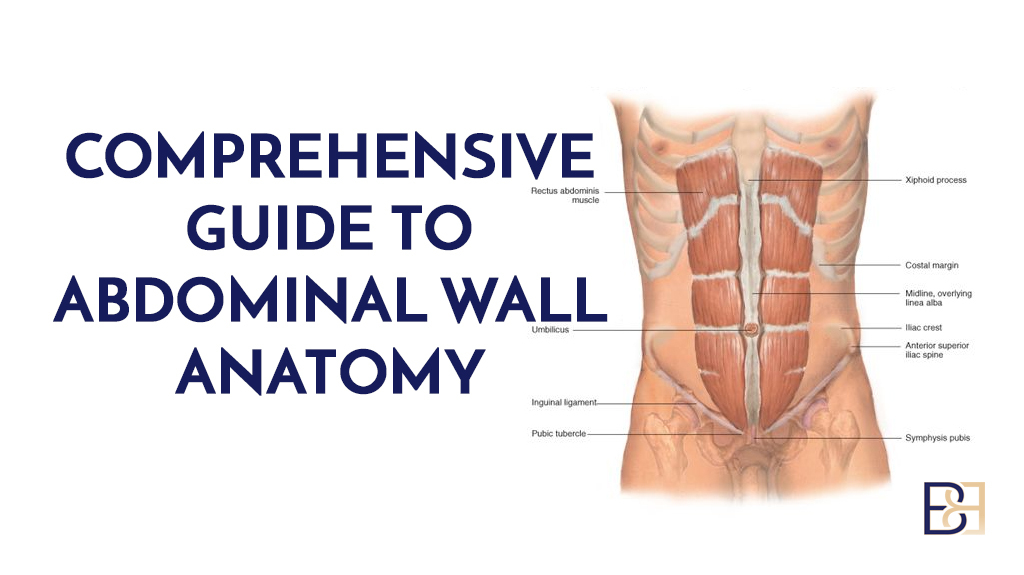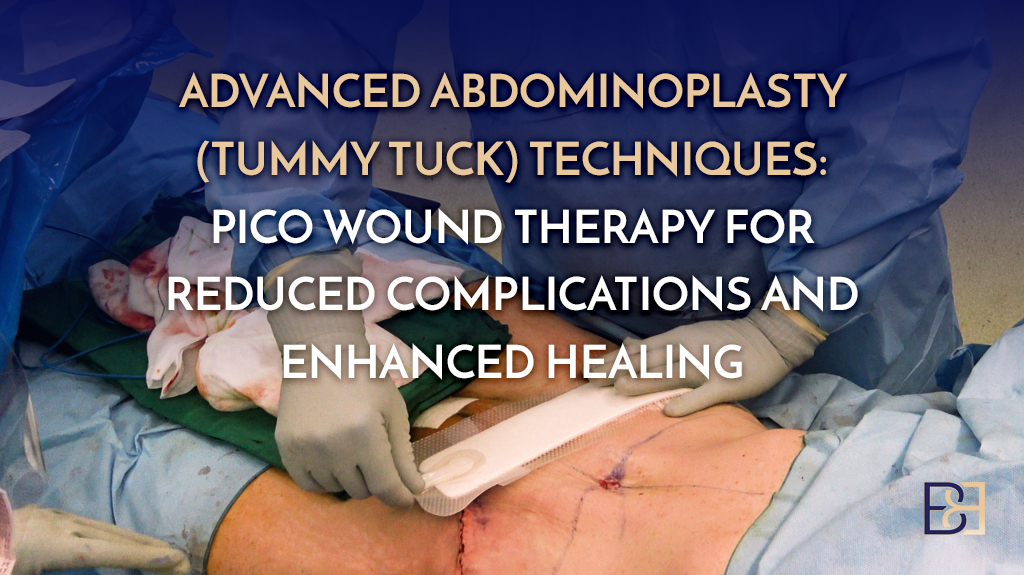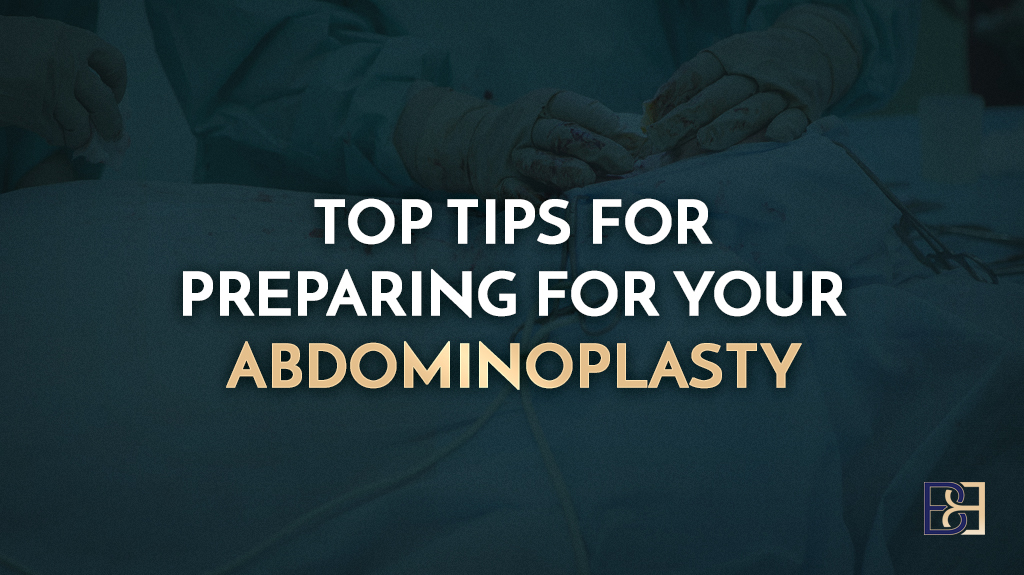While a traditional abdominoplasty aims to remove excess skin from the lower abdomen, the aim of a Fleur-de-Lis Abdominoplasty procedure is to remove loose abdominal skin and excess fat on the lower and upper abdomen. Fleur-de-Lis Abdominoplasty (FDL) is a surgical procedure for individuals who have experienced extensive weight loss following bariatric surgery or post-pregnancy.
After significant weight loss due to weight loss surgery or following multiple pregnancies, many people experience skin excess in the upper and lower abdomen. If you’ve tried eating a balanced diet, exercise, and non-surgical solutions, FDL could be an excellent solution.

Book your appointment online now
Over the last 15 years, I have successfully performed FDL surgery on multiple patients. Today, I’ll give a brief overview of the procedure and cover everything from the ideal surgical preparations to post-operative care, including how to take care of your PICO dressings and much more.
Starts with a Consult
Before the procedure, you’ll be asked to make an appointment for a consultative session, during which I’ll urge you to share your goals, concerns, and expectations. I will also examine your physical condition, assess your medical history, and learn about any previous surgeries before deciding whether FDL is the best approach for you. Below is a step-by-step guide to the way I approach Fleur-de-Lis abdominoplasty.

Fleur-de-Lis Abdominoplasty Explained
Fleur-De-Lis abdominoplasty is an invasive surgery performed by a specialist surgeon that aims to remove loose skin and fat from the abdominal region. It also repairs separated abdominal muscles. The name Fleur-De-Lis is derived from a French term meaning “flower of a lily,” a name derived from the intersecting vertical and horizontal incisions, which appear as an inverted “T,” used to perform the surgery. The pattern also resembles an iris flower with three petals, hence the name.

The vertical incision extends from the groin area along the midline, with the horizontal incision running from hip to hip. The lengths of these incisions vary depending on how much skin and fat need to be removed.
Who Is a Candidate for Fleur-de-Lis Abdominoplasty
I recommend FDL abdominoplasty if you’ve undergone major weight loss and have significant skin laxity in your upper and lower abdomen. FDL is your ideal procedure because other abdominoplasty practices, such as a standard abdominoplasty, may not adequately target the excess skin on the upper abdomen.
FDL could also be suitable if you have pre-existing midline surgery scars, such as subcostal scars on your upper belly. If you meet the above-mentioned criteria, then it’s time we jump to the next step in preparing for FDL surgery.
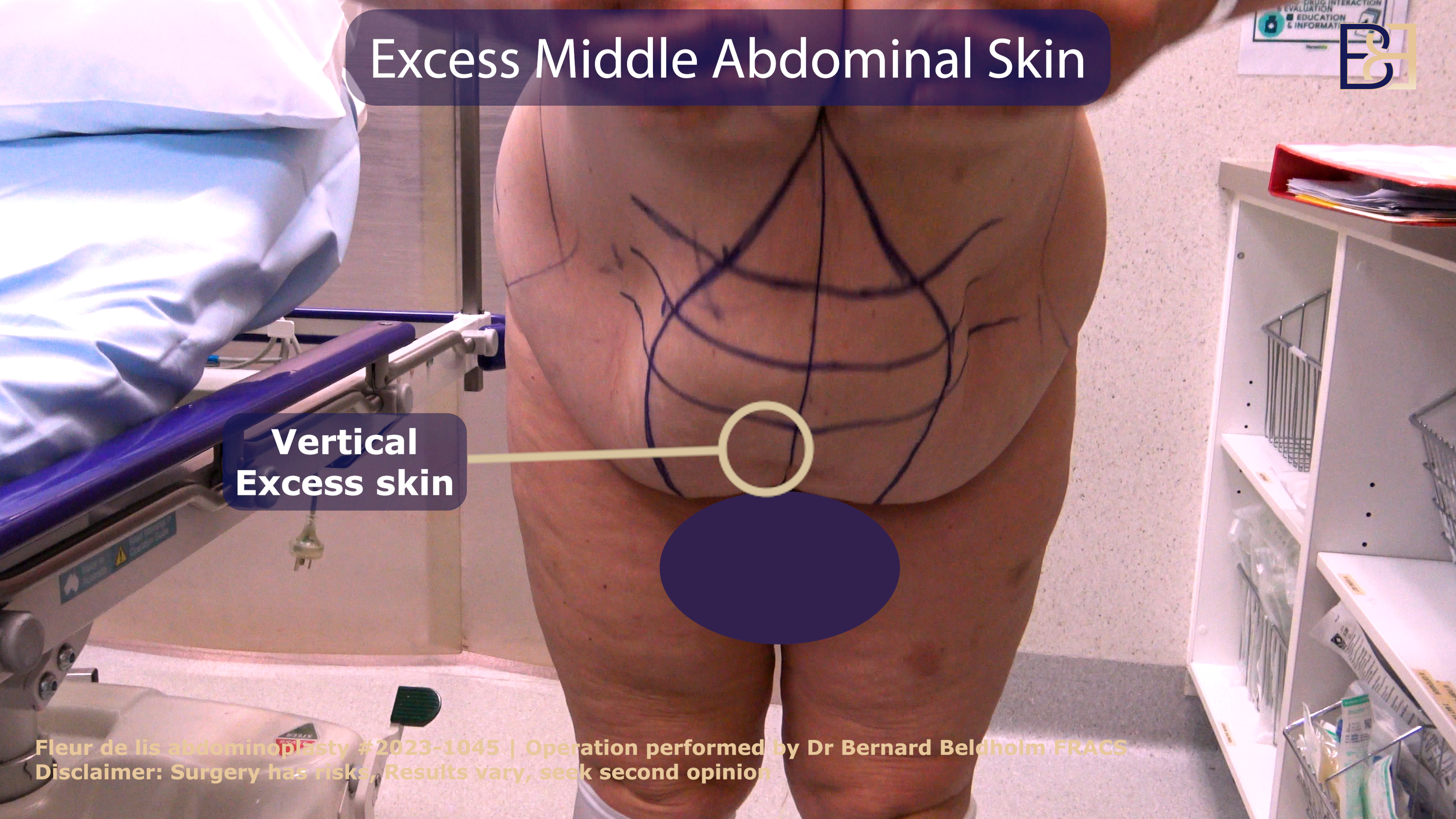
How to Prepare for Your Fleur-de-Lis Abdominoplasty
Prior to your FDL body contouring procedure, we will have a consultation session. During our interaction, I will aim to learn about your:
Medical history
General health condition
Previous surgeries
Medications or supplements
Your expectations and your goals
After that, I will perform various physical exams to establish the condition of your general health. Based on my experience, I will also make other surgical recommendations to reduce potential risks and complications.
For instance, if you are a smoker, I advise you to quit smoking for a minimum of six weeks before and after your procedure to prevent poor wound healing. An NLM, National Library of Medicine study shows that “[s]moking is associated with delayed healing, wound infection, and dehiscence. Smokers with wounds can avoid these risks if they refrain from smoking, even if only for a short-term period while the wound is healing.”
I also recommend eating a balanced diet to facilitate healing. Furthermore, I will advise against taking various blood-thinning prescriptions and supplements, such as aspirin, for a specified period.
Our consultative session will be comprehensive, and we will go further into other topics such as:
Obtaining assistance driving home once released from the hospital after your procedure
Your ideal home setup after the procedure
Additionally, I will answer any other questions you might have regarding Fleur-de-Lis abdominoplasty
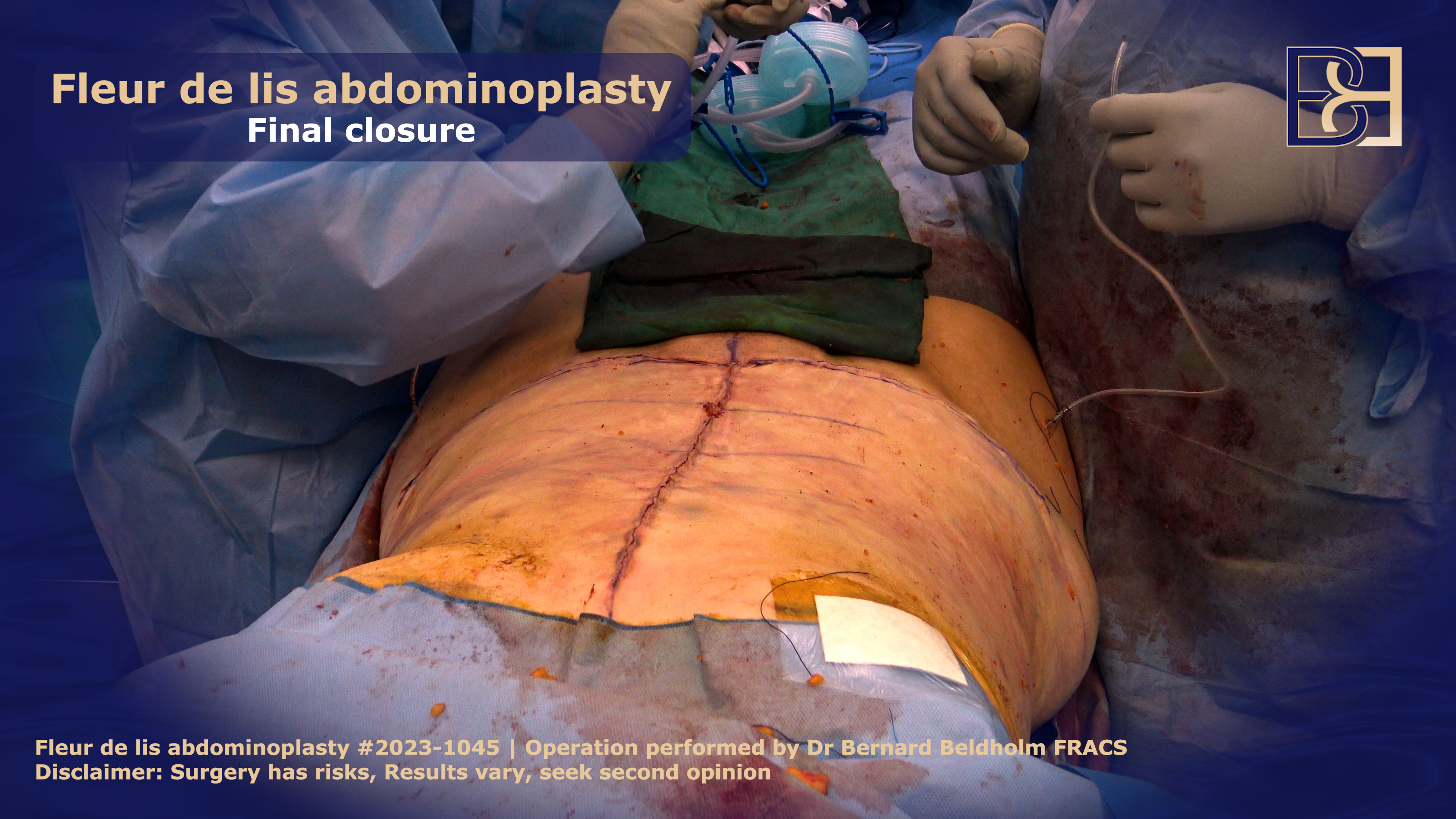
Benefits of Fleur-de-Lis Abdominoplasty
Some of the major FDL benefits include:
reduced loose skin
Repairs separated abdomen muscles (Diastasis recti)
Significant loose skin on your midsection and lower abdomen
Creates a smaller waist
Disadvantages of FDL Abdominoplasty
Some Fleur-de-lis surgery drawbacks include:
Longer recovery period
Higher risk for wound infection
Extended scarring
Higher cost
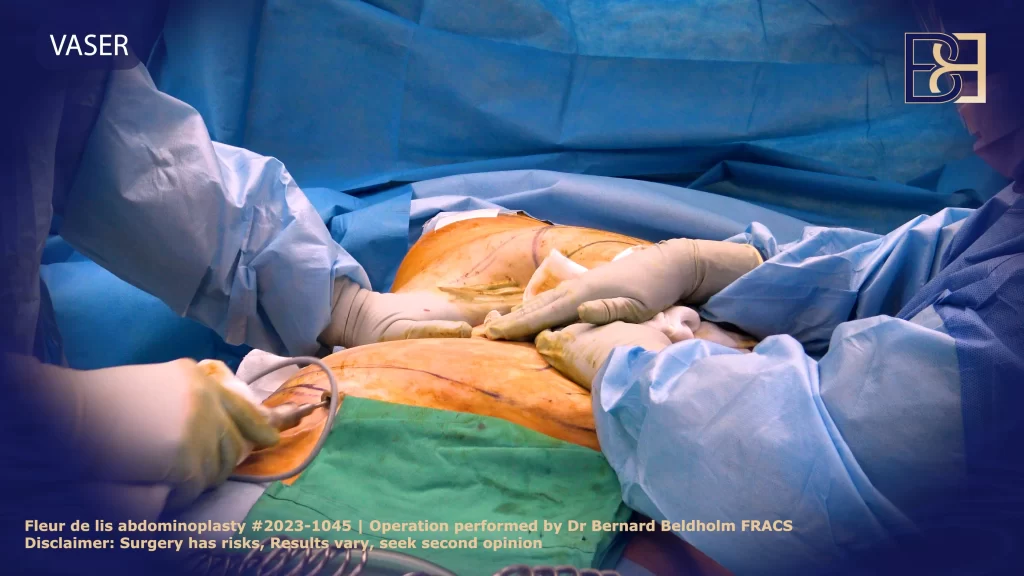
Fleur-de-Lis (FDL) Abdominoplasty Surgery Guide
Consultation with Dr. Beldholm in Lorn
Your Fleur-de-Lis abdominoplasty begins with a conversation, during which I will provide you with important information on the procedure. We will also make crucial assessments, such as your medical conditions, drug allergies, and previous surgeries, to ensure a positive outcome.
We will also review the entire procedure, from pre-operative preparations, surgery length, and anaesthesia to your recovery timetable, pain management, and post-surgical care.

What to Expect During Your Abdominoplasty Consultation?
Among other things, we will discuss the following:
Surgical goals
Medical information
Lifestyle
Surgical history
Health evaluation
Take photos
Surgical options
Plan your treatment

What Happens Next?
Scheduling
After our session, if you decide to move forward, you’ll meet with the patient coordinator, who will provide a price quote, advise you about availability, and schedule your surgery. They will also assist you with questions related to Medicare and insurance coverage.
Remember, the consultation session is not intended to rush or pressure you into scheduling a procedure, nor should you feel obligated to do so. Its purpose is to enable me to assess your situation, learn your goals and expectations, and determine the best course of action while enlightening you with all the necessary information.
Book your appointment online now
Surgery Preparation
Before we begin the procedure, we will take some time to answer any last-minute questions or concerns you may have.
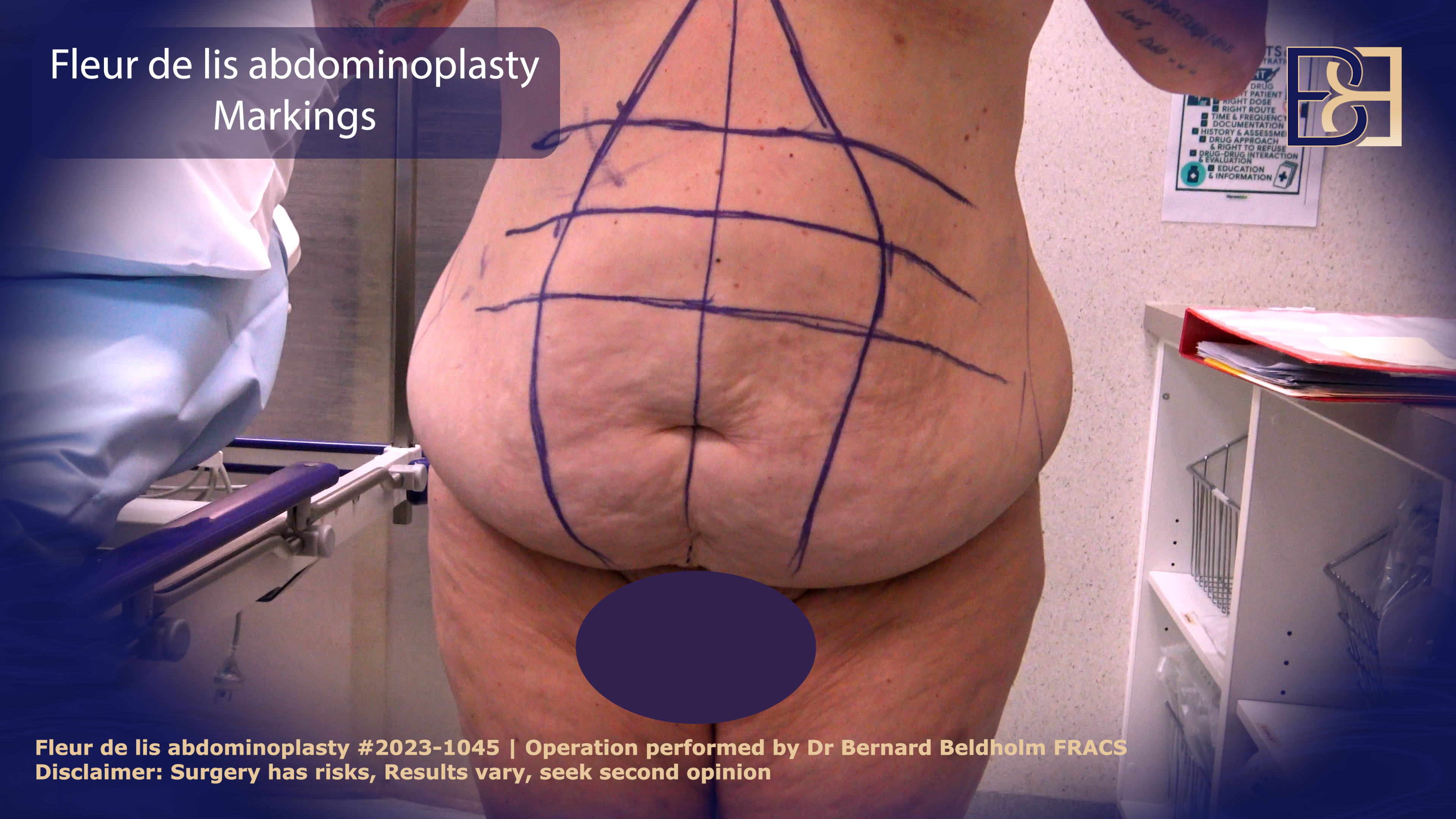
Markings
Upon admittance to the anaesthetic bay, I will use an indelible marker to mark your abdomen. My first marking is the full abdominoplasty incision, where I will make a hip-to-hip horizontal line and a small vertical line running along your upper abdomen midline.
The other vertical marking will feature two lines, creating an inverted V pattern. I will do a standard “pinch test” to determine the ideal incision length. If your procedure involves removing significant excess skin, I will make the markings resemble the inverted V shape to increase the incision area.
These two horizontal and vertical patterns will join in your groin area, creating a lily flower-like pattern.
Body Position on the Operating Table
Once the marking is complete, you will lie on your back in the supine position on the table. At this point, you are ready for your fleur de lis procedure to begin.
Anaesthesia
FDL is an invasive major surgery, requiring general anaesthesia. The anaesthesia will sedate you to ensure you experience no sensation, memory, or pain during your procedure. Another study by NLB shows that “{general anaesthesia} effectively alleviated preoperative anxiety and resulted in lower levels of perioperative anxiety and psychological stress compared to local anaesthesia.”
Our anaesthetist will also insert a tube into your breathing canal to assist with your breathing. They will be present throughout your procedure to monitor vitals such as oxygen and anaesthesia levels. You will be given pain medications through an IV after surgery to help alleviate the discomfort.
Incorporating VASER Suction-Assisted Lipectomy (Liposuction)
If necessary for optimal results, I will combine VASER Suction-Assisted Lipectomy (Liposuction) for optimal contouring. This procedure involves using strong ultrasound waves for removal of the fat deposits present in your abdomen by breaking them down and liquefying them. This promotes extraction, leading to better results.
You should expect the VASER Suction-Assisted Lipectomy (Liposuction) portion of your procedure to extend the length of surgery by about an hour.
Both less aggressive and more effective than traditional liposuction methods, VASER Suction-Assisted Lipectomy (Liposuction) involves several steps.
Application of Wetting Solution
I begin by inserting a cannula, a hollow tube, by making incisions on your excision site, which I will use to apply the wetting solution to your fat tissues. The cannula features a pump that I will use to distribute the solution evenly.
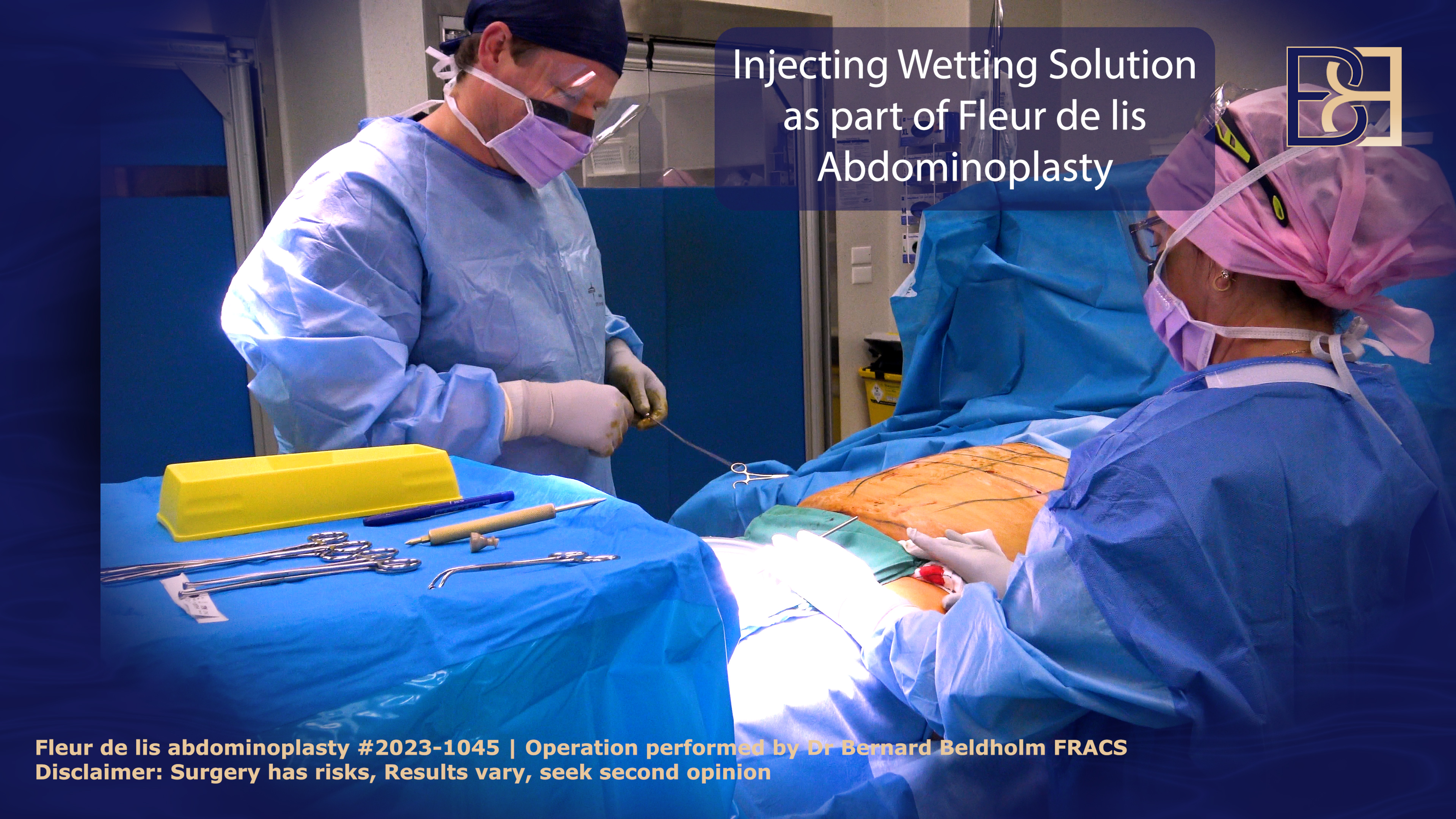
I generally use tumescent fluid as a wetting substance because it contains lignocaine, adrenaline, sodium bicarbonate, and saline, which are essential in making the tissues swell and firm.
Protecting the Skin
Liposuction (suction-assisted lipectomy) involves using a VASER probe, which oscillates at high frequencies, making it hot. To avoid burns, it is crucial to cover and protect your skin. Some of the measures I will take to protect your skin include using wet cloths to cover your naked skin, using protective ports to cover insertion points, and applying sufficient fluid to your tissues.
Fat Melting
Next, I’ll insert the oscillating VASER probe using the insertion areas and move it back and forth. The probe emits ultrasonic energy, causing the applied wetting solution to form bubbles that dislodge and emulsify the fat.
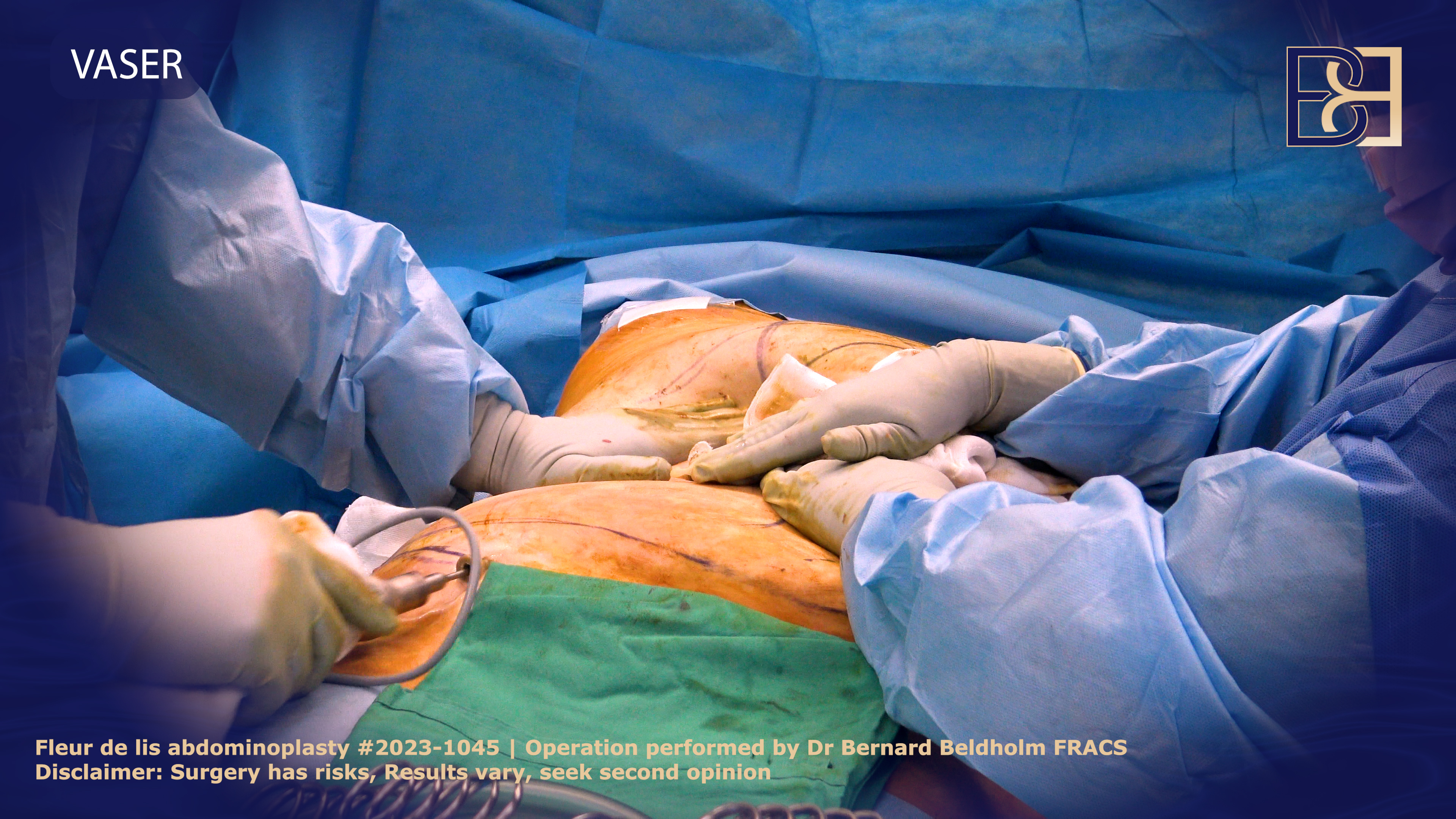
Once the fat becomes emulsified, the VASER probe experiences less resistance, signalling that it’s time for fat removal. I will operate the VASER probe precisely to ensure no damage to the adjacent blood vessels, tissues, or nerves.
Fat Removal
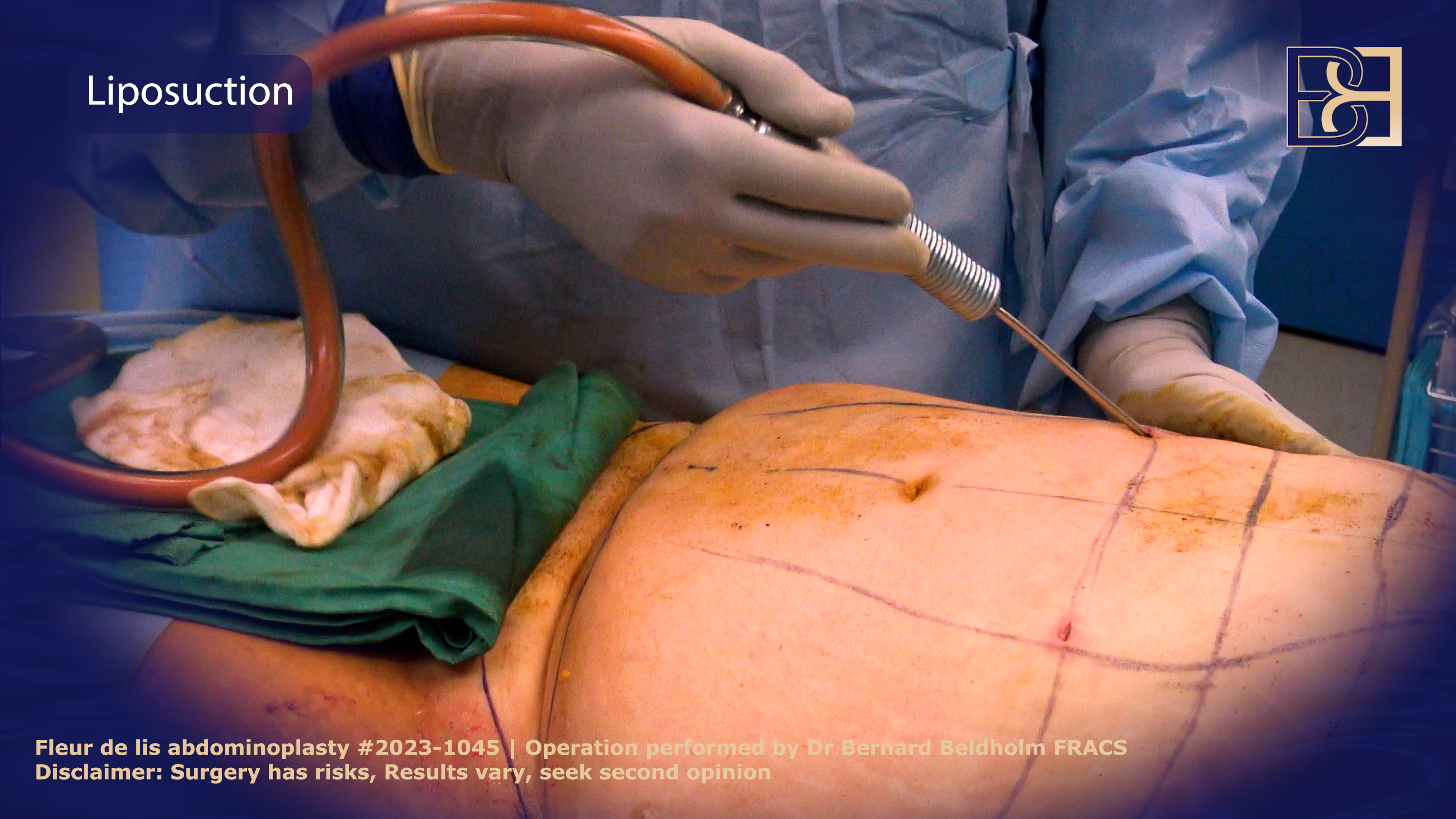
Next, I will remove the emulsified fat through the cannula.
Umbilicus Incision
I will free your Umbilicus before I remove the excess skin on the vertical incision part. This involves making an additional incision around your umbilicus to ensure your umbilical stalk stays attached to the muscles.
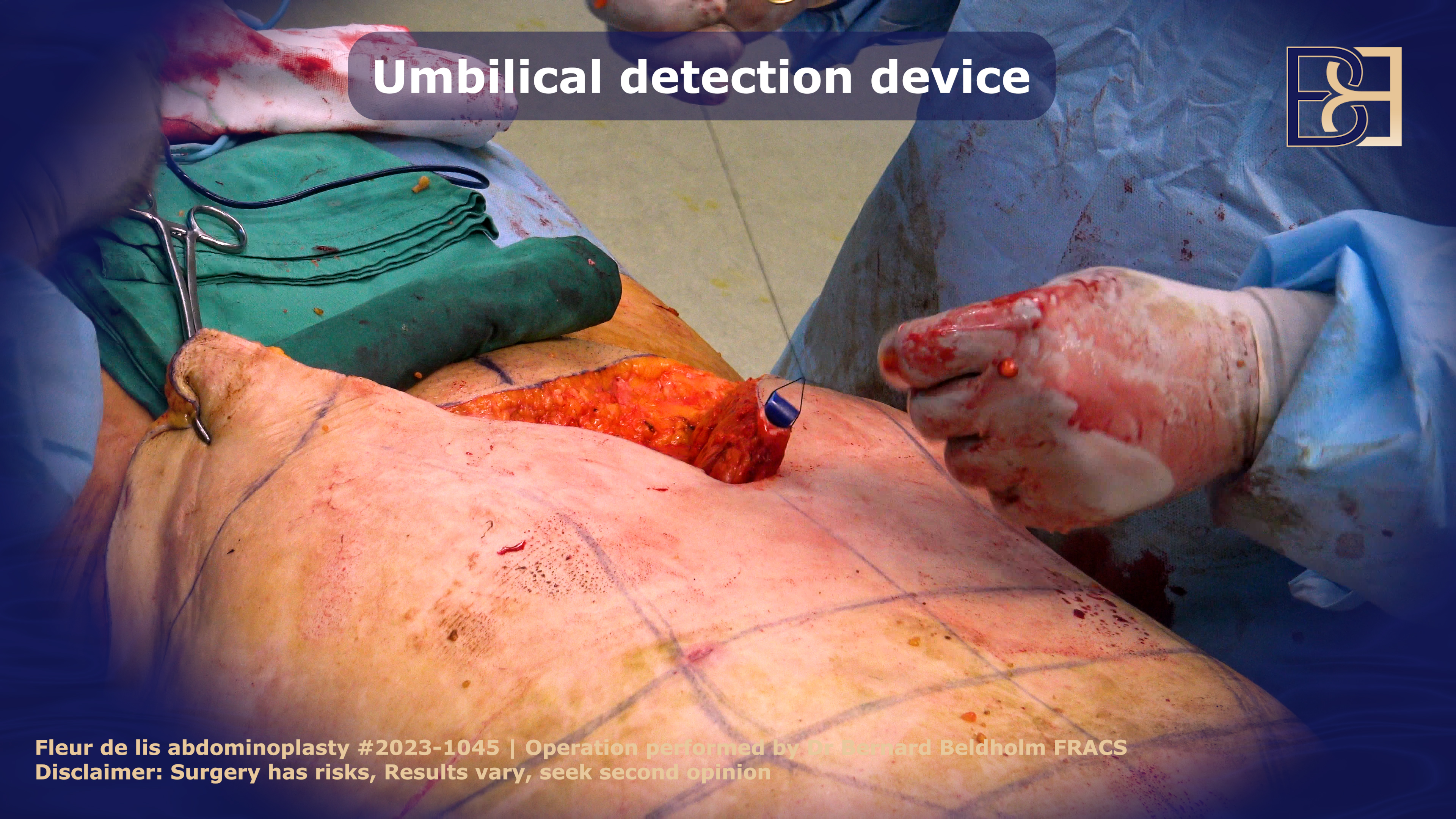
My assistant will ensure the tissues next to your belly button stays stabilised to prevent them from moving. I will also stitch a small plastic piece onto your umbilical stalk to make it less challenging to locate later.
Vertical Incision
I will follow the markings to make the vertical incision that will aid in removing the excess skin around your midsection. I’ll seal any affected blood vessels using diathermy to reduce bleeding and maintain homeostasis.
Removing Loose Skin
The next step is to free the excess skin from its underlying tissue.
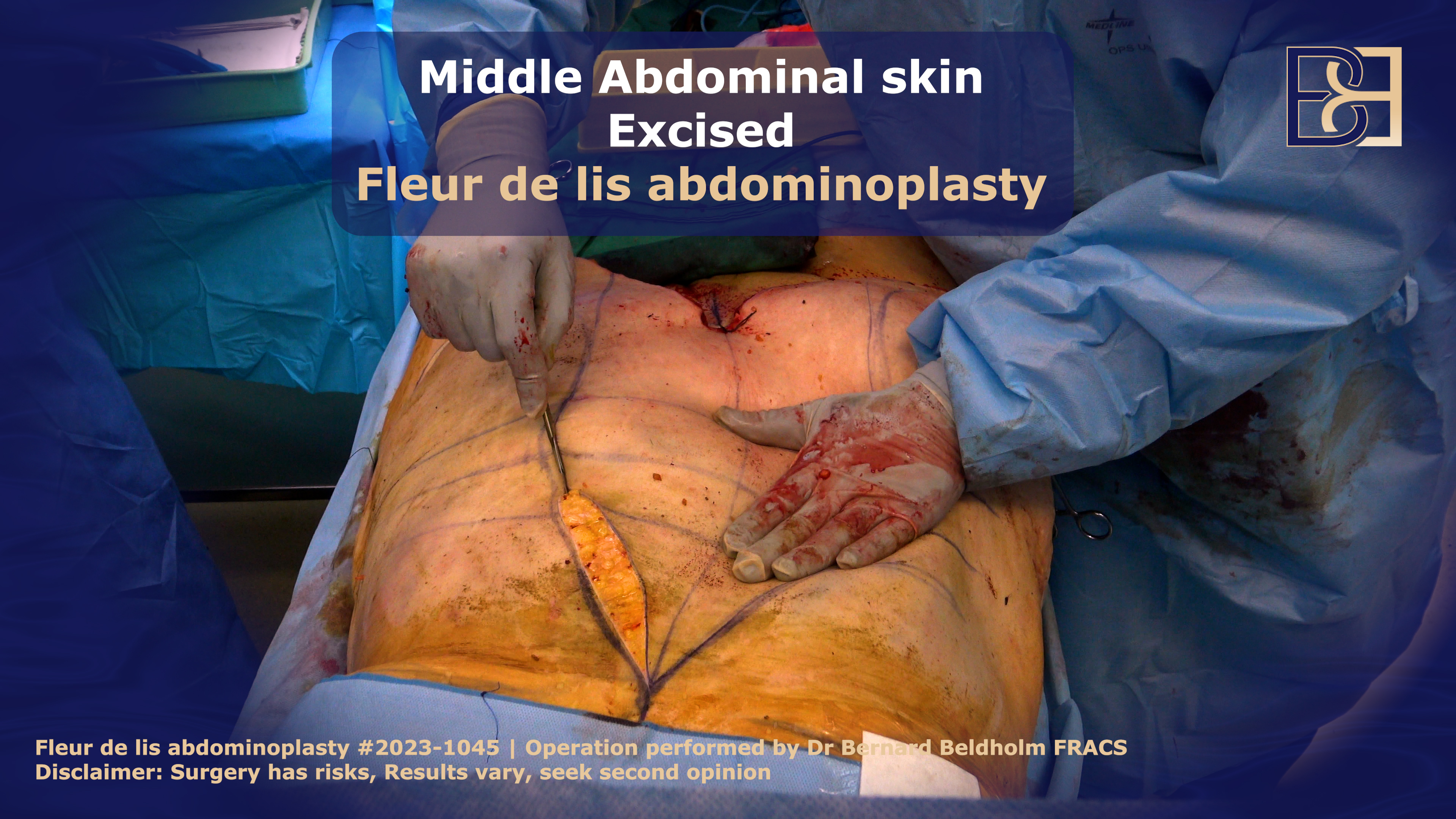
I will first perform a trial using sutures to gather and secure the excess skin at your midline. This will help me determine the correct amount of skin to remove. Then, I will make marks on the loose skin.
Closing the Incision
Next, I will close the created vertical incision, beginning with the deep layers and progressing to the ones near the surface. I will use absorbable sutures on the deeper layers and ARTISS glue during the process to reduce seroma risks.
Horizontal Incision
Next, it’s time to create the horizontal incision. This incision, which is similar to the one used during standard abdominoplasty, will target excess skin in your lower abdomen.
I will make a horizontal incision on the marked areas and close any blood vessels affected during the incision. This is crucial in reducing bleeding as I free the loose skin from underlying tissues.
I aim to have the incision going slightly below your Fascia of Scarpa, which is white and easily detectable. I refrain from going above your Fascia of the Scarpa to ensure your nerves, blood flow, and lymphatics stay intact. This approach also minimises the need to remove excess surgical wound fluid using drains, preventing fluid accumulation.
Muscle Repair
Muscle repair involves using a V-loc suture to repair the separated muscles. V-loc is my ideal choice because it hooks on the separated tissues and doesn’t knot. This reduces operation time and ensures you don’t feel any sutures under your skin after the procedure.
Repositioning the Belly Button
After the removal of significant skin and body fat, I will reposition your belly button to ensure it looks natural. I will then suture it into the incision’s vertical extent for the final close.
Closing Your Incision
I will use Vicryl sutures to close your Fascia of the Scarpa, because they can withstand a good deal of tension without sacrificing their vascularity. I’ll also use barbed sutures to close the deeper layers, absorbing sutures for overlying layers, and tissue glue.
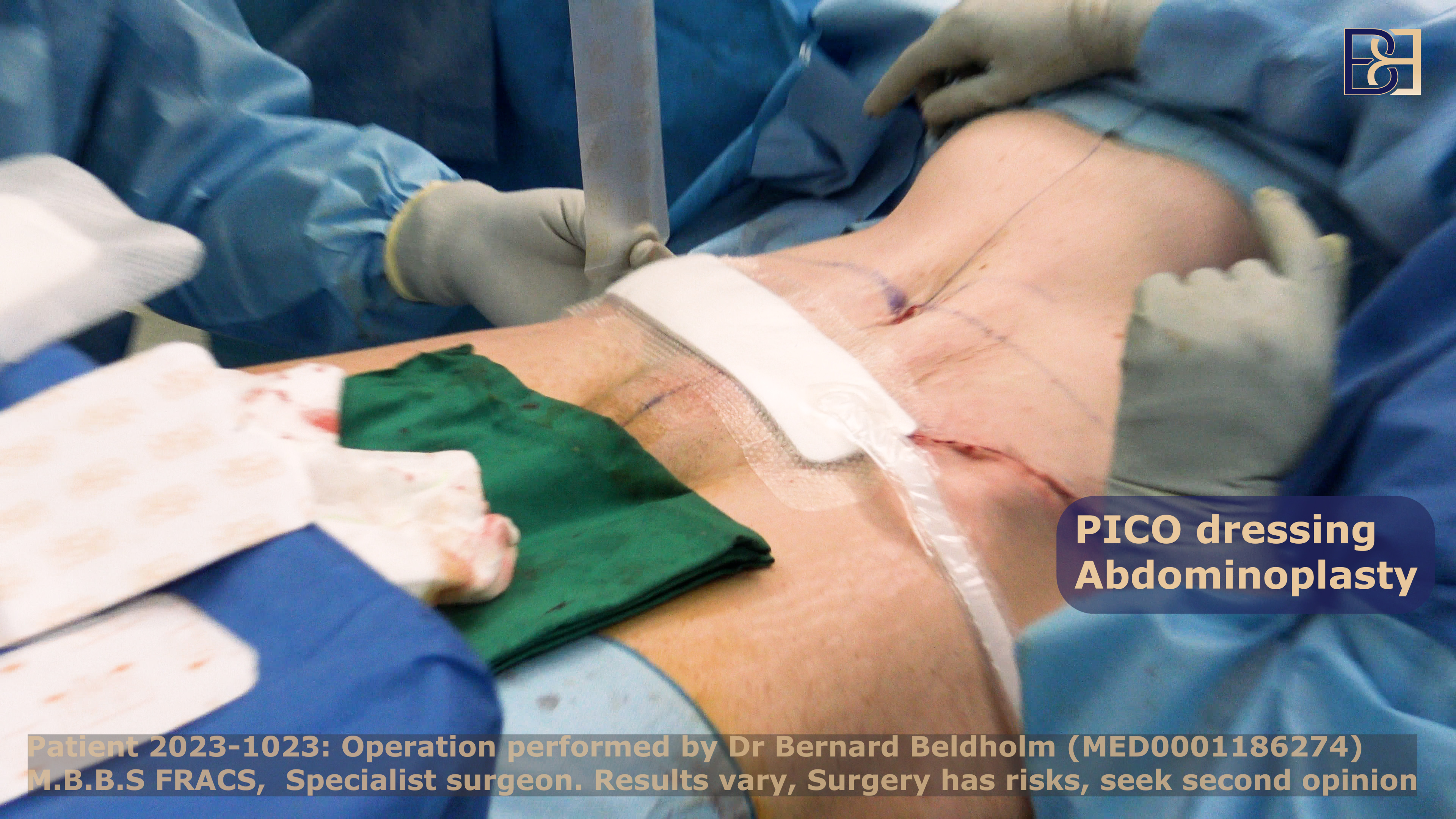
PICO Wound Therapy Dressings
At this point, your FDL procedure is almost complete. I will use PICO Negative Pressure Wound Therapy (NPWT) to cover your surgical wounds. These PICO dressings create negative pressure using a battery pack.
Your PICO dressings will remain in place for eight to eleven days after surgery.
You won’t be able to take a full shower until I remove the PICO wound dressing since the battery attached to it can’t get wet. I usually remove the PICO dressing seven to nine days after the operation. Until then, you can take sponge baths if needed, being extremely careful not to allow the PICO dressing or battery to get wet.
Compression Garment
Next, I will apply compression garments to help reduce swelling and seroma. You will be instructed to wear these garments for about five weeks after your FDL procedure.
Recovery
It is imperative that you follow all post-surgical instructions and guidelines to facilitate optimal recovery. With that in mind, here is a general overview of what to expect during your recovery.
Remaining in Hospital After Your FDL Abdominoplasty
I recommend that you spend 2-4 days in our hospital to allow us to closely monitor your progress after your FDL procedure. Though this might seem like a long time, it prevents you from having to contend with any potential complications on your own, and prevents the need for returning to the hospital to receive corrective measures which could be dangerous and put you out-of-commision for an even greater period of time.
Showering
You won’t be able to take a full shower until the PICO wound dressing is removed, which is normally 7 to 9 days after surgery. This is because the attached battery pack cannot get wet. Until then, take “bird baths,” being extremely careful not to get the PICO dressing or battery wet.
In addition, you will be instructed to wait much longer before immersing yourself in a bath.
Time off from Work, Driving, and Exercising
You should take about four weeks off from work to allow your body to heal. It will also take about three weeks to resume normal activities such as driving and about eight weeks to resume exercising.
Download our infographic: “15 Exercises to Try After Abdominoplasty”
Results
Keep in mind that each patient recuperates at their own pace, and there is no one-size-fits all timeline when it comes to recovery. As such, it can take at least twelve months for the swelling to completely subside, with incision scars potentially taking up to 24 months to fade.
Risks and Complications
FDL is invasive, which means there is the potential for various risks and complications, such as:
Hematoma
Seroma
Blood clots
Poor scarring
Necrosis
Nerve damage
Poor body reaction to administered anaesthesia
Uncontrolled bleeding
Wound infection
Asymmetry
Skin sensation loss
Undesirable results that might require revision
FAQs
Is FDL Surgery Painful?
It is completely normal to experience significant pain for one to two days immediately after your FDL abdominoplasty. I will prescribe medication to help manage this pain, after which it will gradually subside.
Who is a Good Candidate for FDL Abdominoplasty?
A good candidate for FDL is someone who has experienced significant weight loss and has abdominal skin laxity, especially in the upper abdomen and sides, and that cannot be adequately treat with a standard Abdominoplasty procedure.
Will FDL Abdominoplasty Surgery Leave Visible scars?
FDL abdominoplasty surgery involves incisions, which will result in scars. However, over time, scars typically fade and become less noticeable with proper care and scar management techniques.
Can I Combine Other Procedures with FDL Abdominoplasty?
Yes! You can combine FDL with VASER liposuction to contour the abdomen further. However, you should discuss this decision during our initial consultation.
Personal Conclusion from Dr. Beldholm
FDL is an excellent solution for patients with significant skin laxity in the upper and lower abdomen. In this article, it was my goal to explain the invasive nature of this procedure and why it is a suitable option compared to standard abdominoplasty for many post-weight loss patients. I have highlighted crucial information about the procedure, potential risks, and recovery expectations to prepare you for the journey ahead. Please make a note of any questions or concerns you may still have, and feel free to discuss them during our consultative session.
References
- Guo C, Gao T. The advantages of general anaesthesia subthalamic deep brain stimulation for Parkinson’s disease in the enhanced recovery after surgery: A randomised clinical trial. Health Sci Rep. 2023 Dec 10;6(12):e1766.
- Wallach SG. Abdominal contour surgery for the massive weight loss patient: the fleur-de-lis technique. Aesthet Surg J. 2005 Sep-Oct;25(5):454-65.
- Normandin S, Safran T, Winocour S, Chu CK, Vorstenbosch J, Murphy AM, Davison PG. Negative Pressure Wound Therapy: Mechanism of Action and Clinical Applications. Semin Plast Surg. 2021 Aug;35(3):164-170.
- Mendes FH, Donnabella A, Fagotti Moreira AR. Fleur-de-lis Abdominoplasty and Neo-umbilicus. Clin Plast Surg. 2019 Jan;46(1):49-60.
- Ljungqvist O, Scott M, Fearon KC. Enhanced Recovery After Surgery: A Review. JAMA Surg. 2017 Mar 1;152(3):292-298
- Kean J. The effects of smoking on the wound healing process. J Wound Care. 2010 Jan;19(1):5-8.
- Varadhan KK, Lobo DN, Ljungqvist O. Enhanced recovery after surgery: the future of improving surgical care. Crit Care Clin. 2010 Jul;26(3):527-47, x.
- Friedman T, O’Brien Coon D, Michaels V J, Purnell C, Hur S, Harris DN, Rubin JP. Fleur-de-Lis abdominoplasty: a safe alternative to traditional abdominoplasty for the massive weight loss patient. Plast Reconstr Surg. 2010 May;125(5):1525-1535.
- Mitchell RT, Rubin JP. The Fleur-De-Lis abdominoplasty. Clin Plast Surg. 2014 Oct;41(4):673-80.
- Ziegler UE, Ziegler SN, Zeplin PH. Modified Fleur-de-lis Abdominoplasty for Massive Weight Loss Patients. Ann Plast Surg. 2017 Aug;79(2):130-134


